Why is renewable energy getting cheaper?
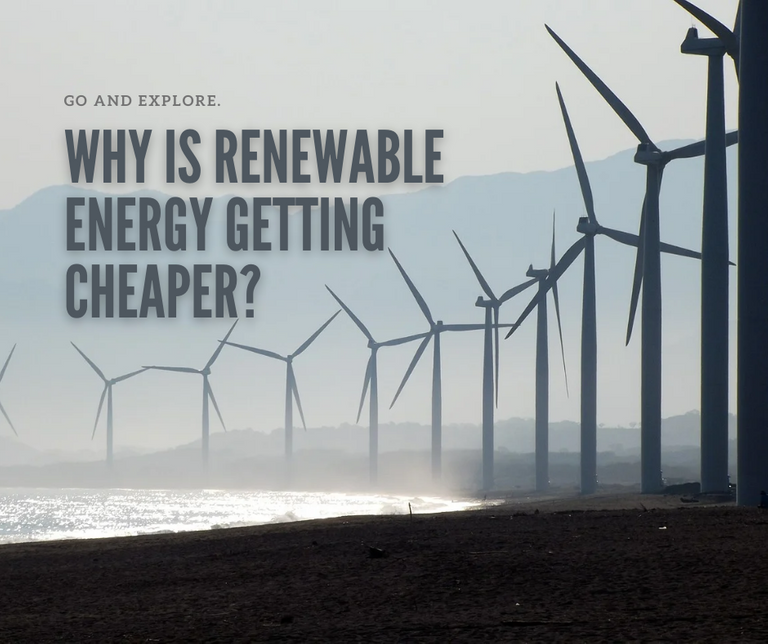
We can transition to low-carbon power generation when energy from these sources must be less expensive than electricity from fossil fuels. Fossil fuels dominate the global power supply because it was much cheaper than electricity generated by renewables. The cost of renewables immensely improved in the last decade, and we are approaching the dawn of renewable energy dominance (maybe not sooner). New renewable technologies are now cheaper, cost-effective than new fossil fuels in most parts of the world.
The cost of renewable energy dropped even more in the last year to a recent report. It decreases to the point that almost any renewable energy source becomes cost-competitive with oil, coal, and gas-fired power plants. Hydroelectric generation remains the cheapest renewable energy source. It has an average of $0.05 per kilowatt-hour (kWh) in building new plants. On the other hand, the average cost of building onshore wind, solar photovoltaic (PV), biomass, or geothermal power plant is typically less than $0.10/kWh, while offshore wind is about $0.13/kWh.
The global averages worth noting when the cost of each project can vary hugely around $0.05/kWh to a high of almost $0.25/kWh, but these averages are competitive enough for consideration over the cost of developing new power plants based on fossil fuels, which typically around $0.05/kWh to over $0.15/kWh. The fossil fuels such as coal, oil, and gas shared about 79% of the global energy supply to date.
The safest and cleanest source of electricity
Our ancestors learned how to produced electricity from fossil fuels to make our jobs more profitable two centuries ago. It sparked the Industrial Revolution. Since then, we have a growing supply of inexpensive electricity, which critical to the advancements we are experiencing to date. While we enjoy the cheaper cost of electricity from fossil fuels, we incur significant negative implications for our environment. Above 58 million people die due to pollution, which burning fossil fuels contribute immensely. When we eliminate two-thirds of death due to air pollution, it is three to four million deaths per year.
When we rely upon our electricity generation on fossil fuels, it becomes unsustainable in the long run. Burning fossil fuels contributes about 87% of the world's CO2 emissions together with industries. It will hurt the livelihood of the future generation and our environment. We can't deny that each energy resources have a negative effect. The fossil fuels are the dirtiest and most dangerous even it is cheaper and economical. Aside from pollution, mining and extraction of fossil fuels have a high risk of accidents.
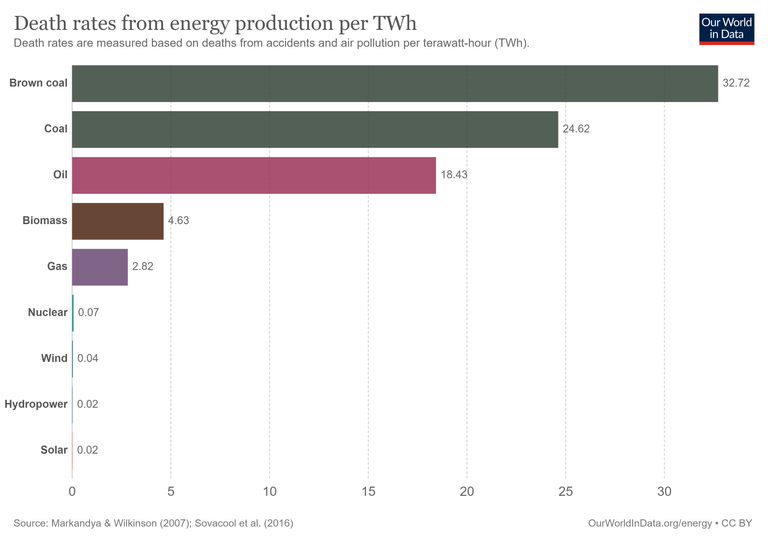
Death rates from energy production per TWh from World in Data
With all of these drawbacks, fossil fuels still dominate the global electricity supply due to, in the past, they are cheaper than nuclear and renewables energy. We must find a better energy solution that is sustainable than rely heavily upon fossil fuels. Nuclear and modern renewable energy sources are vastly safer and cleaner than fossil fuels. For example, nuclear energy has a lesser risk of deaths than coal, steel, gasoline, and petrol, which has 97.5 to 99.8% fewer deaths and injury attributed to it.
Anil Markandya and Paul Wilkinson published a paper that shows a detailed analysis of death rates from fossil fuels, nuclear, hydropower, and biomass. The study considered accidents such as Chernobyl's nuclear disaster and occupation accidents in the mining and plants. In that time, the health burdens are appreciably smaller from natural gas and lower still for nuclear power. However, nuclear energy generation remains contentious due to public fears over nuclear waste disposal and a disastrous accident or terrorist threat.
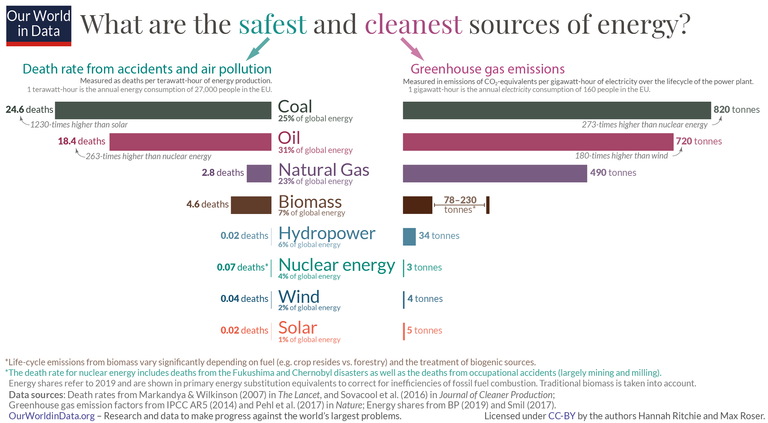
Plot created by Hannah Ritchie and Max Roser
Nuclear energy kills far fewer people than fossil fuels. It comes as a surprise to many people. It is due to people vividly remember the Chernobyl and the Fukushima incident, which are two big nuclear disasters to date. For Chernobyl, there are several death estimates, but we rely on the WHO report that 4000 people have or will die from the Chernobyl disaster, of which 31 people died in the vicinity. The Fukushima tragedy killed 574 people. In 2018, the Japanese government reported only one worker had died from lung cancer due to radiation exposure, but nobody died directly from the Fukushima disaster.
Accounting for all factors, Anil Markandya and Paul Wilkinson attribute 0.022 deaths per TWh from nuclear energy. For renewable energy, the death rates are too low. On average, wind energy generation has a relatively low death rate, which it will take 29 years before someone died. Hydropower and solar have a close death rate that it takes 42 and 53 years for someone to die.
Safer energy sources are also cleaner and getting cheaper.
Coal is the most harmful; hence it has high health costs due to air pollution and injuries, and it releases a significant amount of greenhouse gas emissions. Oil and gas are way better than coal but much inferior to nuclear and renewables on all counts. When choosing energy resources, we don't trade off because the safer energy is the least polluting. Nuclear, wind, hydropower, and solar are safer in terms of accidents and air pollution. These are sustainable low-carbon options for us to adapt to our energy profile.
Nuclear and renewable energy shared about 10% of the global energy demand in 2019. We can still see fossil fuels dominate the energy market. Fossil fuel influenced our energy markets due to our infrastructure built from them and fueled by the Industrial Revolution. Our early investment in fossil fuel resulted in the current cheaper cost to modern renewables. When we factor out the environmental impact and health risk on the cost of fossil fuel, it is relatively costly than nuclear and renewables. Imposing aggressive carbon taxes may hurt fossil fuels and would raise the price to a new height.
On the other hand, renewables technologies are getting cheaper than fossil fuels. A recent report published by International Renewable Energy Agency (IRENA) shared that unsubsidized renewable energy is becoming the cheapest source of energy generation. Onshore wind and solar PV are the most appealing clean energy sources. Renewable energy can now compete with fossil fuel technologies due to the significant decrease in the cost of building new plants.
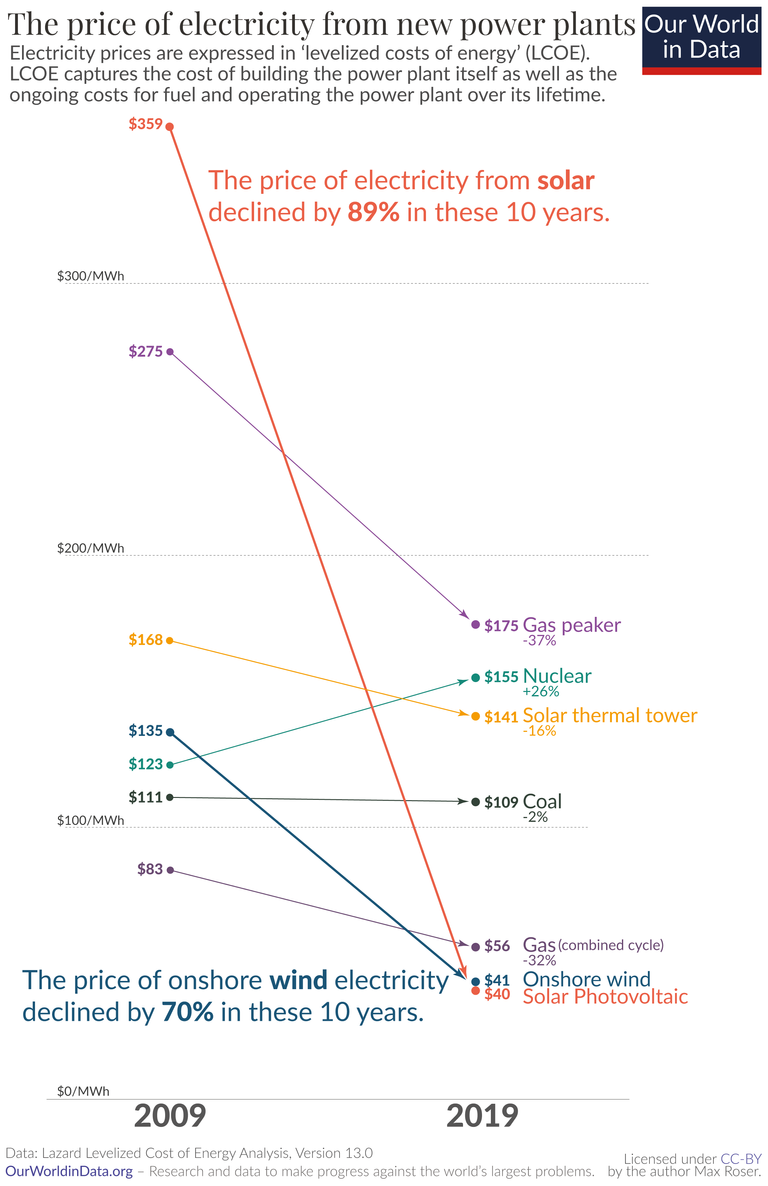
Plot created by Max Roser
The falling cost of renewables
In 2019, the global weighted-average cost for renewables fell by 11%, 13%, and 14% for onshore wind, solar PV, and bioenergy, respectively. We have the sharpest drop in cost for concentrating solar power (CSP) plants which is 26%, while construction costs new plants for geothermal and offshore wind drop by 1%. We can expect the trend to continue over the decade. In 2009, utility-scale solar photovoltaic electricity cost $359 per MWh. Within a decade, the price fell by 89% and flipped the overall cost.
The energy price that we need to break even with a new average coal plant is higher than installing a wind or solar plant. We determine the cost of fossil fuels and nuclear power by the price of our fuels that we used and the running costs of the power plant. We priced renewable energy plants differently. The operating costs are comparatively low to fossil fuels; hence we do not have to pay for any fuel.
In 1956, we $1,865 for one watt of solar photovoltaic power (considering inflation and 2019 prices). We knew one watt is not much. Today, we a single solar panel; generates around 320 watts, and it would cost lesser than in 1956, which would be about $596,800 for a single solar panel in 1956. Renewable isn't competitive to the prices that fossil fuel brings to the table. Solar technology continues to develop over the decades due to still being relevant to power satellites. In 1958, the Vanguard I satellite was the first practical usage of solar panels. Besides, the more we produce solar panels caused the cost drop; hence we are finding a way to improve the technology.
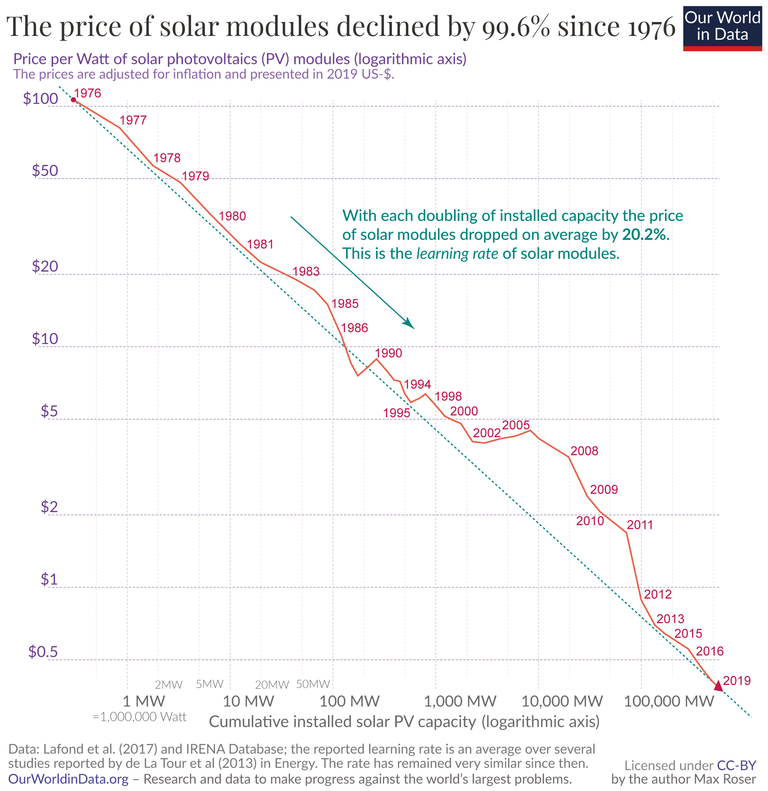
Plot created by Max Roser
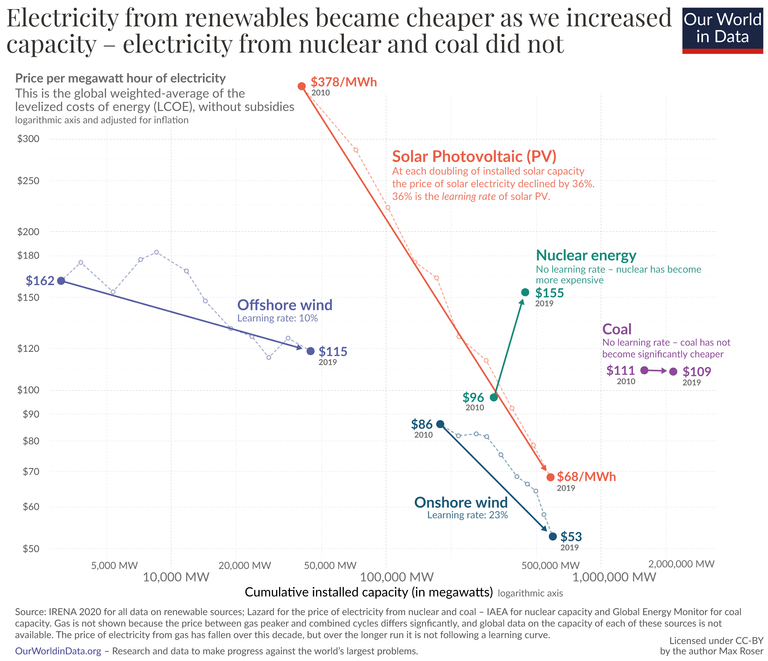
Plot created by Max Roser
In 1976, the price of the solar module was $106 per watt. When we compared the solar panel price to the cost in 1956, it has a 94% drop, but still very expensive due to fewer people adopting it. The total installed solar PV capacity in the world was just 0.3 megawatts, which is enough only for about 20 people per year. For more than four decades, we can see the doubling rate of global cumulative capacity stayed relative to the price decline. The advances that made this price reduction possible span the entire production process of solar modules. We see a price decline of 99.6%, from $106 to $0.38 per watt.
Since 2008, we see the prices plummet 60% for large-scale solar and 40% for wind. We can attribute it to the government incentivizing renewable technologies. Countries looked for renewable energy to meet the UN climate accord. Some countries see renewables as a solution to reduce their severe air pollution. The IRENA report shows us that using renewable energy is statistically cost-effective than fossil fuels, even competing with the heavily subsidized fossil fuel industry. Due to the effects of climate change, we are championing the use of renewables energies to address climate change and sustainability without trading off the economy.
References
- Koch, Wendy. Why Solar and Wind Are Thriving Despite Cheap Fossil Fuels. 2016
- Roser, Max. Why did renewables become so cheap so fast? And what can we do to use this global opportunity for green growth?. 2020
- Ritchie, Hannah. What are the safest and cleanest sources of energy?. 2020
- Ellsmoor, James. Renewable Energy Is Now The Cheapest Option - Even Without Subsidies. 2019
- Dudley, Dominic. Renewable Energy Costs Take Another Tumble, Making Fossil Fuels Look More Expensive Than Ever
- Sehgal, Suraj. The Paradox Of Renewable Energy. 2016
- IRENA. Renewables Increasingly Beat Even Cheapest Coal Competitors on Cost. 2020
- Kretchmer, Harry. Renewables are increasingly cheaper than coal. 2020
- Chrobak, Ula. Solar power got cheap. So why aren’t we using it more?. 2021
- McBain, Bonnie. Renewables are getting cheaper all the time – here’s why. 2016
Note: The cover image is created by the author in Canva.
Thanks for your contribution to the STEMsocial community. Feel free to join us on discord to get to know the rest of us!
Please consider supporting our funding proposal, approving our witness (@stem.witness) or delegating to the @stemsocial account (for some ROI).
Please consider using the STEMsocial app app and including @stemsocial as a beneficiary to get a stronger support.
Congratulations @juecoree! You have completed the following achievement on the Hive blockchain and have been rewarded with new badge(s) :
Your next target is to reach 30000 upvotes.
You can view your badges on your board and compare yourself to others in the Ranking
If you no longer want to receive notifications, reply to this comment with the word
STOPCheck out the last post from @hivebuzz:
Support the HiveBuzz project. Vote for our proposal!
While renewable energy is getting cheaper, I am not particularly sure if it is making it much cleaner. Because old solar panels, wind turbines and other energy producing sources are filling up the land fills. I don't know the exact cost base analysis for it but I find it missing from a bunch of the renewable energy articles.
I agree that even though it is cheaper, it doesn't mean cleaner. We still have electronic and solid waste coming from renewables (similar to what you have pointed out). I think this is a research gap for renewables.